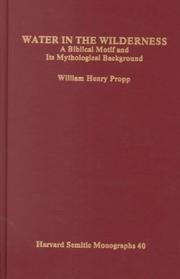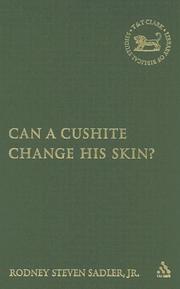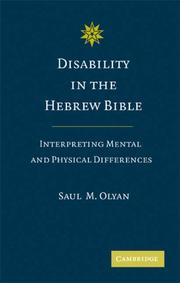| Listing 1 - 10 of 15 | << page >> |
Sort by
|
Book
ISBN: 1315711079 1322509743 1317490851 1845537343 9781315711072 9781317490838 9781317490845 9781845532895 9781845532901 1845532899 1845532902 1317490843 9781322509747 9781317490852 9781845537340 Year: 2009 Publisher: London Equinox
Abstract | Keywords | Export | Availability | Bookmark
 Loading...
Loading...Choose an application
- Reference Manager
- EndNote
- RefWorks (Direct export to RefWorks)
The city is an ambiguous symbol in the Bible. The founder of the first city is the murderer, Cain. The city of Jerusalem is the place chosen by God, yet is also a place of wrong-doing and injustice. Jesus seems to have largely avoided cities except Jerusalem, where he was crucified. The City in Biblical Perspective examines the archaeological and social background of the urban biblical world and explores the implications of the deliberate ambiguities in the biblical text. The book aims to deepen our understanding of both the biblical and the contemporary city by asking how the Bible's complex understanding of the city can illuminate our own ever more urban time.
Cities and towns --- Biblical teaching. --- 22.08*3 --- 221.08*3 --- 221.08*3 Theologie van het Oude Testament: themata --- Theologie van het Oude Testament: themata --- 22.08*3 Bijbelse theologie: themata --- Bijbelse theologie: themata --- Biblical teaching --- Cities and towns - Biblical teaching.
Book
ISBN: 9780300121827 0300245637 0300121822 9780300245639 Year: 2018 Publisher: New Haven Yale University Press
Abstract | Keywords | Export | Availability | Bookmark
 Loading...
Loading...Choose an application
- Reference Manager
- EndNote
- RefWorks (Direct export to RefWorks)
The first contemporary analysis of Bedouin and biblical cultures sheds new light on biblical laws, practices, and Bedouin history.
Bedouins in the Bible --- 221.08*3 --- 221.08*3 Theologie van het Oude Testament: themata --- Theologie van het Oude Testament: themata --- Bedouins in the Bible. --- Bedouins --- Nomads --- Nomadic peoples --- Nomadism --- Pastoral peoples --- Vagabonds --- Wanderers --- Persons --- Herders --- Beduins --- Arabs --- Ethnology --- North Africans --- Social life and customs. --- Bible --- Criticism, interpretation, etc.

ISBN: 1555401570 9004369457 9781555401573 9789004369450 Year: 1987 Volume: 40 Publisher: Atlanta Scholars Press
Abstract | Keywords | Export | Availability | Bookmark
 Loading...
Loading...Choose an application
- Reference Manager
- EndNote
- RefWorks (Direct export to RefWorks)
Water in the Bible. --- Bible. --- Criticism, interpretation, etc. --- 221.08*3 --- Theologie van het Oude Testament: themata --- 221.08*3 Theologie van het Oude Testament: themata --- Water in the Bible --- Antico Testamento --- Hebrew Bible --- Hebrew Scriptures --- Kitve-ḳodesh --- Miḳra --- Old Testament --- Palaia Diathēkē --- Pentateuch, Prophets, and Hagiographa --- Sean-Tiomna --- Stary Testament --- Tanakh --- Tawrāt --- Torah, Neviʼim, Ketuvim --- Torah, Neviʼim u-Khetuvim --- Velho Testamento --- Palaia Diathēk
Book
ISBN: 1575066971 9781575066974 9781575062679 1575062674 Year: 2021 Publisher: University Park, PA
Abstract | Keywords | Export | Availability | Bookmark
 Loading...
Loading...Choose an application
- Reference Manager
- EndNote
- RefWorks (Direct export to RefWorks)
Bernard F. Batto spent the bulk of his career examining the ancient Near Eastern context of the Hebrew Bible, with particular interest in the influence of the surrounding cultures on the biblical creation stories. This collection gathers six of his most important previously published essays and adds two new contributions. Among the essays, Batto identifies various creation motifs prevalent in the ancient Near East and investigates the reflexes of these motifs in Genesis 1–11 and other biblical accounts of the primeval period. He demonstrates how the biblical writers adapted and responded to the creation ideas of Mesopotamia, Egypt, Ugarit, and elsewhere.The articles in the volume were written as independent essays. Nevertheless, they are united by theme. Throughout, Batto makes clear his understanding of the Hebrew Bible as a patently unique text, yet one that cannot possibly be understood independent of greater cultural sphere in which it developed. In the Beginning will serve as an indispensable resource for those interested in both the biblical ideas of creation and the mythology of the ancient Near East that influenced them.
Creation --- Middle Eastern literature --- Biblical teaching. --- History and criticism. --- Bible. --- Criticism, interpretation, etc. --- Middle East --- Religion. --- -221.08*3 --- 231.51 --- 231.51 De Deo creatore. Schepping --- De Deo creatore. Schepping --- 221.08*3 Theologie van het Oude Testament: themata --- Theologie van het Oude Testament: themata --- Biblical cosmogony --- Cosmogony --- Natural theology --- Teleology --- Beginning --- Biblical cosmology --- Creation windows --- Creationism --- Evolution --- Biblical teaching --- Religion --- History and criticism --- Bible. -- Genesis I-XI -- Criticism, interpretation, etc. --- -Middle East

ISBN: 1281802409 9786611802400 0567515737 9780567515735 0567029603 9780567029607 0567029700 9780567029706 Year: 2005 Publisher: New York: T&T Clark International,
Abstract | Keywords | Export | Availability | Bookmark
 Loading...
Loading...Choose an application
- Reference Manager
- EndNote
- RefWorks (Direct export to RefWorks)
How did the authors of the Hebrew Bible perceive the Cushites? Sadler demonstrates that the answer to this question provides insights into the way differences that modern scholars would classify as "racial" were understood in ancient Israel/Judah. By examining explicit biblical references to Cush and Cushites, a nation and people most modern scholars would deem racially "black," this book explores the manner by which the authors of the Hebrew Bible represented the Cushite, and determines whether differences in human phenotypes facilitated legitimating ideologies that justified the subjugation
Blacks in the Bible. --- Cushites. --- Hamites --- Negro race in the Bible --- Bible. --- Antico Testamento --- Hebrew Bible --- Hebrew Scriptures --- Kitve-ḳodesh --- Miḳra --- Old Testament --- Palaia Diathēkē --- Pentateuch, Prophets, and Hagiographa --- Sean-Tiomna --- Stary Testament --- Tanakh --- Tawrāt --- Torah, Neviʼim, Ketuvim --- Torah, Neviʼim u-Khetuvim --- Velho Testamento --- Criticism, interpretation, etc. --- Blacks in the Bible --- Black people in the Bible. --- Cushites --- 221.08*3 --- 221.08*3 Theologie van het Oude Testament: themata --- Theologie van het Oude Testament: themata
Book
ISBN: 1317591445 131574421X 9781317591443 1317591437 9781317591436 9781317591450 1317591453 1844658112 9781844658114 9781315744216 Year: 2014 Publisher: Abingdon Routledge
Abstract | Keywords | Export | Availability | Bookmark
 Loading...
Loading...Choose an application
- Reference Manager
- EndNote
- RefWorks (Direct export to RefWorks)
The prophetic books of the Old Testament offer a fascinating collection of oracles, poetic images, and theological ideas. Among the most prominent themes are those of judgment and salvation, especially concerning the fate of Zion. This place, where the people of God dwell, is alternately presented as either the object of divine wrath or the image of a salvific ideal. Representing Zion provides a thorough and critical study of the images of Zion in the entire prophetic literature of the Old Testament. The book challenges traditional interpretations of Zion and offers a fresh exploration of the literary and theological nature of the biblical writings. Zion has largely been treated by scholars as an image of the inviolable city consistently and unambiguously used by Old Testament authors. Representing Zion reveals the Zion motif to be contested, complex and profoundly theological-a reflection of the ambiguous role of YHWH as judge and saviour.
Bible. -- Old Testament -- Criticism, interpretation, etc. --- Religion --- Philosophy & Religion --- Judaism --- 221.08*3 --- 224 --- 221.08*3 Theologie van het Oude Testament: themata --- Theologie van het Oude Testament: themata --- Profetische boeken van het Oude Testament --- Bible. --- Antico Testamento --- Hebrew Bible --- Hebrew Scriptures --- Kitve-ḳodesh --- Miḳra --- Old Testament --- Palaia Diathēkē --- Pentateuch, Prophets, and Hagiographa --- Sean-Tiomna --- Stary Testament --- Tanakh --- Tawrāt --- Torah, Neviʼim, Ketuvim --- Torah, Neviʼim u-Khetuvim --- Velho Testamento --- Criticism, interpretation, etc.
Book
ISBN: 9780300166361 9780300166538 0300166532 0300166362 Year: 2015 Publisher: New Haven Yale University Press
Abstract | Keywords | Export | Availability | Bookmark
 Loading...
Loading...Choose an application
- Reference Manager
- EndNote
- RefWorks (Direct export to RefWorks)
Works created in the period from the Babylonian conquest of Judea through the takeover and rule of Judea and Samaria by imperial Persia reveal a profound interest in the religious responses of individuals and an intimate engagement with the nature of personal experience. Using the rich and varied body of literature preserved in the Hebrew Bible, Susan Niditch examines ways in which followers of Yahweh, participating in long-standing traditions, are shown to privatize and personalize religion. Their experiences remain relevant to many of the questions we still ask today: Why do bad things happen to good people? Does God hear me when I call out in trouble? How do I define myself? Do I have a personal relationship with a divine being? How do I cope with chaos and make sense of my experience? What roles do material objects and private practices play within my religious life? These questions deeply engaged the ancient writers of the Bible, and they continue to intrigue contemporary people who try to find meaning in life and to make sense of the world. The Responsive Self studies a variety of phenomena, including the use of first-person speech, seemingly autobiographic forms and orientations, the emphasis on individual responsibility for sin, interest in the emotional dimensions of biblical characters, and descriptions of self-imposed ritual. This set of interests lends itself to exciting approaches in the contemporary study of religion, including the concept of "lived religion," and involves understanding and describing what people actually do and believe in cultures of religion.
Self --- Judaism --- 221.08*02 --- 221.08*3 --- 221.08*3 Theologie van het Oude Testament: themata --- Theologie van het Oude Testament: themata --- 221.08*02 Theologie van het Oude Testament: Mens--(antropologie) --- Theologie van het Oude Testament: Mens--(antropologie) --- Jews --- Religions --- Semites --- Religious aspects. --- History --- Religion --- Bible. --- Antico Testamento --- Hebrew Bible --- Hebrew Scriptures --- Kitve-ḳodesh --- Miḳra --- Old Testament --- Palaia Diathēkē --- Pentateuch, Prophets, and Hagiographa --- Sean-Tiomna --- Stary Testament --- Tanakh --- Tawrāt --- Torah, Neviʼim, Ketuvim --- Torah, Neviʼim u-Khetuvim --- Velho Testamento --- Criticism, interpretation, etc. --- Religious aspects --- Religious life.
Book
ISBN: 1315539500 113494019X 1844657752 9781134940196 9781845536756 9781315539508 9781134940264 9781134940332 9781138661141 1134940262 Year: 2013 Publisher: Sheffield ; Oakville, CT : Equinox Pub.,
Abstract | Keywords | Export | Availability | Bookmark
 Loading...
Loading...Choose an application
- Reference Manager
- EndNote
- RefWorks (Direct export to RefWorks)
Were David and Jonathan "gay" lovers? This very modern question lies behind the recent explosion of studies of the David and Jonathan narrative. Interpreters differ in their assessment of whether 1 and 2 Samuel offer a positive portrayal of a homosexual relationship. Beneath the conflict of interpretations lies an ambiguous biblical text which has drawn generations of readers - from the redactors of the Hebrew text and the early translators to modern biblical scholars - to the task of resolving its possible meanings. What has not yet been fully explored is the place of David and Jonathan in the evolution of modern, Western understandings of same-sex relationships, in particular how the story of their relationship was read alongside classical narratives, such as those of Achilles and Patroclus, or Orestes and Pylades. The Love of David and Jonathan explores this context in detail to argue that the story of David and Jonathan was part of the process by which the modern idea of homosexuality itself emerged.
Homosexuality in the Bible. --- David, --- Jonathan --- Daud, --- Dāwūd, --- Nabī Dāwūd, --- דוד --- דוד, --- דוד המלך --- David (Biblical figure) --- Jonathan, --- Jonathas --- יהונתן --- Bible. --- Samuel (Book of the Old Testament) --- Shemuʼel (Book of the Old Testament) --- Criticism, interpretation, etc. --- History. --- Gay interpretations. --- Homosexuality in the Bible --- 221-05 --- 221.08*3 --- 222.6 --- 221.08*3 Theologie van het Oude Testament: themata --- Theologie van het Oude Testament: themata --- 221-05 Personen in het Oude Testament --- Personen in het Oude Testament --- Samuelboeken. Boeken der koningen. David. Salomon. Elia. Elisa. Josias

ISBN: 9780521888073 9780511499036 9781107404984 9780511409929 0511409923 9780511408021 0511408021 9780511409387 0511409389 9780511408816 0511408811 0511499035 1281717096 9781281717092 0521888077 1107404983 1107187265 9781107187269 9786611717094 6611717099 0511407289 9780511407284 Year: 2008 Publisher: Cambridge New York Cambridge University Press
Abstract | Keywords | Export | Availability | Bookmark
 Loading...
Loading...Choose an application
- Reference Manager
- EndNote
- RefWorks (Direct export to RefWorks)
Mental and physical disability, ubiquitous in texts of the Hebrew Bible, here receive a thorough treatment. Olyan seeks to reconstruct the Hebrew Bible's particular ideas of what is disabling and their potential social ramifications. Biblical representations of disability and biblical classification schemas - both explicit and implicit - are compared to those of the Hebrew Bible's larger ancient West Asian cultural context, and to those of the later Jewish biblical interpreters who produced the Dead Sea Scrolls. This study will help the reader gain a deeper and more subtle understanding of the ways in which biblical writers constructed hierarchically significant difference and privileged certain groups (e.g. persons with 'whole' bodies) over others (e.g. persons with physical 'defects'). It also explores how ancient interpreters of the Hebrew Bible such as the Qumran sectarians reproduced and reconfigured earlier biblical notions of disability and earlier classification models for their own contexts and ends.
People with disabilities in rabbinical literature --- People with disabilities in the Bible --- 221.08*3 --- Handicapped in the Bible --- Handicapped in rabbinical literature --- Rabbinical literature --- 221.08*3 Theologie van het Oude Testament: themata --- Theologie van het Oude Testament: themata --- Bible. --- Dead Sea scrolls. --- Antico Testamento --- Hebrew Bible --- Hebrew Scriptures --- Kitve-ḳodesh --- Miḳra --- Old Testament --- Palaia Diathēkē --- Pentateuch, Prophets, and Hagiographa --- Sean-Tiomna --- Stary Testament --- Tanakh --- Tawrāt --- Torah, Neviʼim, Ketuvim --- Torah, Neviʼim u-Khetuvim --- Velho Testamento --- Jerusalem scrolls --- ʻAin Fashka scrolls --- Jericho scrolls --- Scrolls, Dead Sea --- Qumrân scrolls --- Rękopisy z Qumran --- Shikai bunsho --- Megilot Midbar Yehudah --- Dodezee-rollen --- Kumránské rukopisy --- Documentos de Qumrán --- Textos de Qumrán --- Rollos del Mar Muerto --- Manuscritos del Mar Muerto --- Manuscrits de la mer Morte --- Dödahavsrullarna --- Kumranin kirjoitukset --- Kuolleenmeren kirjoitukset --- Qumranhandskrifterna --- Qumranin kirjoitukset --- Qumran Caves scrolls --- Criticism, interpretation, etc. --- People with disabilities in the Bible. --- People with disabilities in rabbinical literature. --- Arts and Humanities --- Religion
Book
ISBN: 1281803421 9786611803421 0567590291 9780567590299 9781850753599 1850753598 9781281803429 6611803424 Year: 1992 Publisher: Sheffield JSOT
Abstract | Keywords | Export | Availability | Bookmark
 Loading...
Loading...Choose an application
- Reference Manager
- EndNote
- RefWorks (Direct export to RefWorks)
This original study concerns itself with the manumission laws of Exodus 20, Deuteronomy 15 and Leviticus 25. It begins with the social background to debt slavery and the socioeconomic factors encouraging the rise of debt slavery in Mesopotamia. After a comparative analysis of the Mesopotamian and biblical material Chirichigno examines the social background to debt slavery in Israel, the various slave laws in the Pentateuch (in order to delimit the chattel-slave laws from the debt-slave laws), and the biblical manumission laws themselves.
Slavery --- Slavery in the Bible. --- Debt --- Abolition of slavery --- Antislavery --- Enslavement --- Mui tsai --- Ownership of slaves --- Servitude --- Slave keeping --- Slave system --- Slaveholding --- Thralldom --- Crimes against humanity --- Serfdom --- Slaveholders --- Slaves --- Indebtedness --- Finance --- Law and legislation --- Jews --- History. --- 326 <33> --- Slavery (Jewish law) --- -Middle Eastern literature --- -Slavery in the Bible --- Jewish law --- Near Eastern literature --- 326 <33> Slavernij--(algemeen)--Oud-Palestina. Judea --- Slavernij--(algemeen)--Oud-Palestina. Judea --- History --- Relation to the Old Testament --- 221.08*3 --- Slavery in the Bible --- Vows in the Bible --- 221.08*3 Theologie van het Oude Testament: themata --- Theologie van het Oude Testament: themata --- Bible. --- Criticism, interpretation, etc. --- Antico Testamento --- Hebrew Bible --- Hebrew Scriptures --- Kitve-ḳodesh --- Miḳra --- Old Testament --- Palaia Diathēkē --- Pentateuch, Prophets, and Hagiographa --- Sean-Tiomna --- Stary Testament --- Tanakh --- Tawrāt --- Torah, Neviʼim, Ketuvim --- Torah, Neviʼim u-Khetuvim --- Velho Testamento --- Enslaved persons
| Listing 1 - 10 of 15 | << page >> |
Sort by
|

 Search
Search Feedback
Feedback About UniCat
About UniCat  Help
Help News
News